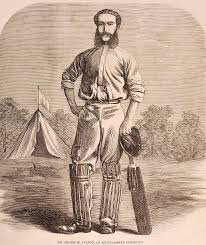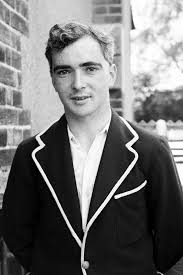Sometimes a stone gets turned over almost by accident, to reveal a long forgotten part of Kent cricket history, and names which mean nothing to us now but which a century and a half ago were on everybody’s lips. An article in a recent issue of Trout and Salmon magazine featured a gentleman called George Mortimer Kelson, described not only as a “Colossus of the salmon fishing world” but also in his prime “the best bat in the Kent eleven.”
There have been many cricketers who also enjoyed their fly fishing, with Ian Botham and Michael Atherton among those of more recent vintage, but it appears that George Kelson was truly a giant among fly fishermen, the man who produced what has come to be considered the definitive list of fly patterns. If you, like me, have almost no knowledge of salmon fishing, and not much greater interest, then do not worry. At this point I will turn my attention to Kelson the cricketer, a man who played his last game for Kent only three years after the formation of the present county club, and well before the start of the official county championship in 1890.

George Mortimer Kelson
Kelson was born on 8th December 1835, in Sevenoaks. His father was a doctor, and Kelson enjoyed a comfortable upbringing. He played cricket for Kent between 1859 and 1873 and in 124 innings for the county, scored 1,810 runs at an average of 15.33, with a highest score of 122, his only century. That was made against Surrey at the Oval in 1863, when Surrey had the strongest team in the land. Despite his heroics, Kent still lost the game by nine wickets, Surrey successfully chasing 192 to win, a huge target in those pre-lawn mower days.
As an aside to that game, Wisden pointed out that “there used to be a little harmless betting on cricket, and the task looked so formidable that (Billy) Caffyn (of Surrey), who had backed Surrey, hedged all his money.” These days he would have been banned for life (subsequently commuted to twenty minutes) for such a ‘harmless’ offence, but until cricket and other sports stop taking money from bookmakers, these stories from Victorian days will repeat themselves interminably.
Kelson also took 41 wickets at 21.17 in his Kent career, with a best bowling analysis of 6 for 30, against Yorkshire at Gravesend in July 1870. In that match he also top scored with 51 in Kent’s first innings, but despite these efforts, Kent still lost the match by eight wickets. He seemed fated to produce his best performances in a losing cause. When he was not playing for Kent, he also played several times for an England XI and for the Gentlemen against the Players, and in all cricket, he scored 2,240 runs and took 76 wickets with his round arm fast medium bowling. In his History of Kent Cricket, R.L. Arrowsmith describes him as “a fine hitter, who did not mind lifting the ball, a useful fast bowler and a good field.” In Kelson’s obituary in Wisden, the editor is a little less enthusiastic, stating that “I cannot recall Mr. Kelson’s batting, though I saw him play, but from all accounts he was a fine punishing player with as free, attractive style.” Kelson also captained the county side when the official captain of the day, W.S. Norton, was not playing.

Tony Pawson
After retiring from playing first-class cricket, Kelson turned to his other love – field sports. He was not only a great fisherman, but also a keen shot, a fox-hunting man and a breeder of racing pigeons. I have no idea whether he had time to earn a living as well, or even if he needed to, but he soon became an authority on fly fishing, and his 1895 book, The Salmon Fly – How To Dress It And How To Use It, quickly became a classic of the genre. I have not read it, and doubt if I ever will, so cannot comment further. I do not think, however, that it earned him huge sums of money. Kelson became fishing editor of a magazine called Land And Water (no connection with the current magazine of the same name), which must have earned him a small crust, at least. He didn’t die of starvation, anyway, and lived to a good age, dying in Sevenoaks in 1920, at the age of 84.
The next year, 1921, another Kentish fly-fishing cricketer was born – Tony Pawson. Pawson, who died aged 91 just a few years ago, was not only a cricketer, but also a fine footballer and a world champion fly fisherman. I well remember seeing him at many Canterbury Weeks and other occasions over the years, a remarkable man who remained mentally and physically fit into old age. He finished with the statistically satisfying – and by no means poor – batting average for Kent of 33.33, and also found time to win an Amateur Cup Winners’ medal with Pegasus in 1953, followed by two games for Charlton Athletic, and, a little later, the world individual fly-fishing championship in 1984. There have not been many all-rounders with as broad a cv as Tony Pawson’s.
I am not aware that any of the current Kent squad do any fishing (except occasionally outside the off stump, which should be discouraged), but I am sure that most of our players have sporting interests that go beyond computer games or Gillingham F.C. George Mortimer Kelson, a typical Victorian sporting gentleman, lived a life that may be difficult for today’s professionals to emulate, but they could do a lot worse than try.
Leave a comment